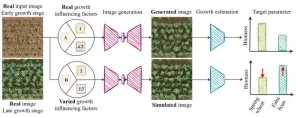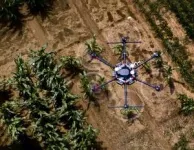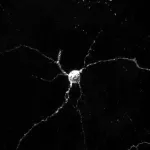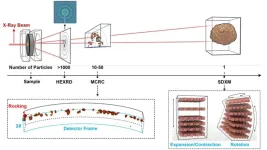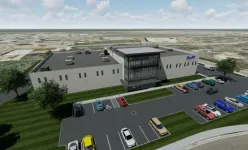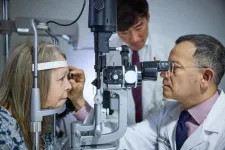(Press-News.org) Researchers at the University of Bonn have developed software that can simulate the growth of field crops. To do this, they fed thousands of photos from field experiments into a learning algorithm. This enabled the algorithm to learn how to visualize the future development of cultivated plants based on a single initial image. Using the images created during this process, parameters such as leaf area or yield can be estimated accurately. The results have been published in the journal Plant Methods.
Which plants should I combine in what ratio to achieve the greatest possible yield? And how will my crop develop if I use manure instead of artificial fertilizers? In the future, farmers should increasingly be able to count on computer support when answering such questions.
Researchers from the University of Bonn have now taken a crucial step forward on the path towards this goal: “We have developed software that uses drone photos to visualize the future development of the plants shown,” explains Lukas Drees from the Institute of Geodesy and Geoinformation at the University of Bonn. The early career researcher is an employee in the PhenoRob Cluster of Excellence. The large-scale project based at the University of Bonn intends to drive forward the intelligent digitalization of agriculture to help farming become more environmentally friendly, without causing harvest yields to suffer.
A virtual glimpse into the future to aid decision-making
The computer program now presented by Drees and his colleagues in the journal Plant Methods is an important building block. It should eventually make it possible to simulate certain decisions virtually – for instance, to assess how the use of pesticides or fertilizers will affect crop yield.
For this to work, the program must be fed with drone photos from field experiments. “We took thousands of images over one growth period,” explains the doctoral researcher. “In this way, for example, we documented the development of cauliflower crops under certain conditions.” The researchers then trained a learning algorithm using these images. Afterwards, based on a single aerial image of an early stage of growth, this algorithm was able to generate images showing the future development of the crop in a new, artificially created image. The whole process is very accurate as long as the crop conditions are similar to those present when the training photos were taken. Consequently, the software does not take into account the effect of a sudden cold snap or steady rain lasting several days. However, it should learn in the future how growth is affected by influences such as these – as well as an increased use of fertilizers, for example. This should enable it to predict the outcome of certain interventions by the farmer.
“In addition, we used a second AI software that can estimate various parameters from plant photos, such as crop yield,” says Drees. “This also works with the generated images. It is thus possible to estimate quite precisely the subsequent size of the cauliflower heads at a very early stage in the growth period.”
Focus on polycultures
One area the researchers are focusing on is the use of polycultures. This refers to the sowing of different species in one field – such as beans and wheat. As plants have different requirements, they compete less with each other in a polyculture of this kind compared to a monoculture, where just one species is grown. This boosts yield. In addition, some species – beans are a good example of this – can bind nitrogen from the air and use it as a natural fertilizer. The other species, in this case wheat, also benefits from this.
“Polycultures are also less susceptible to pests and other environmental influences,” explains Drees. “However, how well the whole thing works very much depends on the combined species and their mixing ratio.” When results from many different mixing experiments are fed into learning algorithms, it is possible to derive recommendations as to which plants are particularly compatible and in what ratio.
Plant growth simulations on the basis of learning algorithms are a relatively new development. Process-based models have mostly been used for this purpose up to now. These – metaphorically speaking – have a fundamental understanding of what nutrients and environmental conditions certain plants need during their growth in order to thrive. “Our software, however, makes its statements solely based on the experience they have collected using the training images,” stresses Drees.
Both approaches complement each other. If they were to be combined in an appropriate manner, it could significantly improve the quality of the forecasts. “This is also a point that we are investigating in our study,” says the doctoral researcher: “How can we use process- and image-based methods so they benefit from each other in the best possible way?”
Participating institutions and funding:
The University of Bonn and Forschungszentrum Jülich took part in the study. The work was funded by the German Research Foundation (DFG) as part of the German Excellence Strategy.
Publication: Lukas Drees, Dereje T. Demie, Madhuri R. Paul, Johannes Leonhardt, Sabine J. Seidel, Thomas F. Döring, Ribana Roscher: Data-driven Crop Growth Simulation on Time-varying Generated Images using Multi-conditional Generative Adversarial Networks; Plant Methods; https://doi.org/10.1186/s13007-024-01205-3, URL: https://plantmethods.biomedcentral.com/articles/10.1186/s13007-024-01205-3
Media contact:
Prof. Dr. Ribana Roscher
Institute of Geodesy and Geoinformation, University of Bonn
Tel. +49 (0)228/7360854
Email: ribana.roscher@uni-bonn.de
Lukas Drees
Institute of Geodesy and Geoinformation, University of Bonn
Tel. +49 (0)228 7360854
Email: ldrees@uni-bonn.de
END
AI shows how field crops develop
Tool developed at the University of Bonn should enable yield forecasts, among other things, in the future
2024-06-17
ELSE PRESS RELEASES FROM THIS DATE:
African research funders in global spotlight through Dimensions indexing project
2024-06-17
African research is receiving a major visibility boost with the indexing of 10 national funders in Dimensions, the world’s largest linked research database.
This project is a collaboration with Digital Science, the Africa PID Alliance (APA), the Association of African Universities (AAU), the Training Centre in Communication (TCC Africa), and the Research Organization Registry (ROR).
“This project connects the research outputs from leading African funding bodies to the global research ecosystem,” said Joy Owango, Executive Director of TCC Africa ...
New study suggests cancer drug could be used to target protein connection that spurs Parkinson’s disease
2024-06-17
FOR IMMEDIATE RELEASE
In studies with genetically engineered mice, Johns Hopkins Medicine researchers say they have identified a potentially new biological target involving Aplp1, a cell surface protein that drives the spread of Parkinson’s disease-causing alpha-synuclein.
The findings, published May 31 in Nature Communications, reveal how Aplp1 connects with Lag3, another cell surface receptor, in a key part of a process that helps spread harmful alpha-synuclein proteins to brain cells. Those protein buildups are hallmarks of Parkinson’s disease.
Notably, the researchers say, Lag3 is already the target of a combination ...
More than 1 in 10 patients at FQHCs experience major social risk factors
2024-06-17
A first-of-its-kind study found high rates of food insecurity, housing insecurity, financial strain, and/or a lack of transportation among patients at federally qualified health centers, particularly patients who were low-income or from racial/ethnic minority populations.
Federally qualified health centers (FQHCs) offer primary care services to 1 in 11 Americans, the majority of whom are low-income and/or underinsured and may not otherwise receive this care. While prior research has shown that 70 percent of FQHCs screen for social ...
Artificial intelligence accurately screens heart failure patients for clinical trial eligibility
2024-06-17
Generative Artificial Intelligence (Gen AI) can rapidly and accurately screen patients for clinical trial eligibility, according to a new study from Mass General Brigham researchers. Such technology could make it faster and cheaper to evaluate new treatments and, ultimately, help bring successful ones to patients.
Investigators assessed the accuracy and cost of a Gen AI process they named RAG-Enabled Clinical Trial Infrastructure for Inclusion Exclusion Review (RECTIFIER), that identifies patients who meet criteria for enrollment in ...
Unlocking the mystery behind the performance decline in a promising cathode material
2024-06-17
The first generation of lithium-ion batteries for electric vehicles has been a remarkable success story. Yet, the question arises: What changes to battery materials will spur further advances to extend driving range and lower costs?
A better positive electrode, or cathode, for lithium-ion batteries has been the focus of intense past research. The cathode is one of the main components in batteries. Several candidates for cathode materials offer the prospect of batteries with much higher energy storage, leading to longer driving range. However, the capacity, or amount of current flowing out within a given time, tends to decline rapidly with charge-discharge cycling for reasons ...
A call for renaming clinical research partnerships
2024-06-17
PHILADELPHIA (June 17, 2024) - In a recently published opinion piece in BMJ Open, “Rhetoric of Research: A Call for Renaming the Clinical Research Partnership,” authors from Penn Nursing and Georgetown University School of Nursing, present a compelling argument for rethinking the language used to describe participants in clinical research. The opinion calls for a shift from the traditional term “patient participant” to “participant partner,” emphasizing the crucial role of participants in ...
SwRI breaks ground on new hypersonic engine research facility
2024-06-17
SAN ANTONIO — June 17, 2024 —Southwest Research Institute (SwRI) today celebrated the groundbreaking of the Center for Accelerating Materials and Processes (CAMP), a new facility that will support research and development for tomorrow’s high-speed aerospace engines.
“This project will help ensure the U.S. is a leader in high-speed propulsion research and development,” said Dr. Barron Bichon, director of SwRI’s Materials Engineering Department. “SwRI is committed to advancing this vital technology on behalf of Texas and the nation.”
Market forces including growth in global defense, air travel, ...
International Gemini Observatory and Subaru combine forces to discover first ever pair of merging quasars at cosmic dawn
2024-06-17
Since the very first instant after the Big Bang the Universe has been expanding. This means that the early Universe was considerably smaller and early-formed galaxies were more likely to interact and merge. Galaxy mergers fuel the formation of quasars — extremely luminous galactic cores where gas and dust falling into a central supermassive black hole emit enormous amounts of light. So when looking back at the early Universe astronomers would expect to find numerous pairs of quasars in close proximity to each other as their host galaxies undergo mergers. However, they have been surprised ...
Repurposed drug may help stabilize vision in rare disease
2024-06-17
Roughly 50 families scattered across the world share ultra-rare variants in a particular gene. Silent for years, the inherited mutations make themselves known when patients reach the fourth decade of life. Changes in vision start a cascade of symptoms. Five to 20 years later, the illness is fatal.
Researchers at Washington University School of Medicine in St. Louis have dedicated many years to understanding the rare condition known as retinal vasculopathy with cerebral leukoencephalopathy and systemic manifestations, or RVCL-S, with the aim of developing a treatment ...
Face screening tool detects stroke in seconds
2024-06-17
A new smartphone face-screening tool could help paramedics to identify stroke in seconds – much sooner and more accurately than is possible with current technologies.
Strokes, which affect millions of people globally, occur when the blood supply to part of the brain is interrupted or reduced, which prevent brain tissue from getting oxygen and nutrients. A few minutes of delay can result in permanent damage to the brain cells.
A team of biomedical engineers at RMIT University developed the AI capabilities behind the software technology and has published their results ...
LAST 30 PRESS RELEASES:
The impact of family dynamics on eating behaviour – how going home for Christmas can change how you eat
Tracing the quick synthesis of an industrially important catalyst
New software sheds light on cancer’s hidden genetic networks
UT Health San Antonio awarded $3 million in CPRIT grants to bolster cancer research and prevention efforts in South Texas
Third symposium spotlights global challenge of new contaminants in China’s fight against pollution
From straw to soil harmony: International team reveals how biochar supercharges carbon-smart farming
Myeloma: How AI is redrawing the map of cancer care
Manhattan E. Charurat, Ph.D., MHS invested as the Homer and Martha Gudelsky Distinguished Professor in Medicine at the University of Maryland School of Medicine
Insilico Medicine’s Pharma.AI Q4 Winter Launch Recap: Revolutionizing drug discovery with cutting-edge AI innovations, accelerating the path to pharmaceutical superintelligence
Nanoplastics have diet-dependent impacts on digestive system health
Brain neuron death occurs throughout life and increases with age, a natural human protein drug may halt neuron death in Alzheimer’s disease
SPIE and CLP announce the recipients of the 2025 Advanced Photonics Young Innovator Award
Lessons from the Caldor Fire’s Christmas Valley ‘Miracle’
Ant societies rose by trading individual protection for collective power
Research reveals how ancient viral DNA shapes early embryonic development
A molecular gatekeeper that controls protein synthesis
New ‘cloaking device’ concept to shield sensitive tech from magnetic fields
Researchers show impact of mountain building and climate change on alpine biodiversity
Study models the transition from Neanderthals to modern humans in Europe
University of Phoenix College of Doctoral Studies releases white paper on AI-driven skilling to reduce burnout and restore worker autonomy
AIs fail at the game of visual “telephone”
The levers for a sustainable food system
Potential changes in US homelessness by ending federal support for housing first programs
Vulnerability of large language models to prompt injection when providing medical advice
Researchers develop new system for high-energy-density, long-life, multi-electron transfer bromine-based flow batteries
Ending federal support for housing first programs could increase U.S. homelessness by 5% in one year, new JAMA study finds
New research uncovers molecular ‘safety switch’ shielding cancers from immune attack
Bacteria resisting viral infection can still sink carbon to ocean floor
Younger biological age may increase depression risk in older women during COVID-19
Bharat Innovates 2026 National Basecamp Showcases India’s Most Promising Deep-Tech Ventures
[Press-News.org] AI shows how field crops developTool developed at the University of Bonn should enable yield forecasts, among other things, in the future
